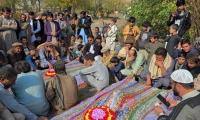Indian foreign policy has traditionally been afflicting the neighbouring countries through its affirmative and hegemonic regional posture. Smaller nations of the South Asia region feel threatened and bigger countries remain wary of India’s dubious demeanor. This disparate nature of policy execution has led to chaos in the region. Chaos is also distributed subtly through adopting long-term policies that create lack of harmony and order in the region, for instance, India’s refusal to attend SAARC Summit 2016, which pressured other regional countries like Afghanistan, Bangladesh and Bhutan to also pull out. This move seems to be counter-productive to India’s claimed regional leadership since true leader cultivates harmony, not disparity and chaos.
Similarly, the pretext of developing nuclear submarines by India for countervailing the Chinese prowling of the Indian Ocean as a security measure in not true as China cannot afford any instability in the Indian Ocean due to economic interests being paramount for China than any confrontation.
According to a New York Times assessment, “China is striving for recognition and respect. Part and parcel of this pursuit includes (1) the eventual reunification of China: after Hong Kong 's and Macao 's return to China 's sovereignty respectively in 1997 and 1999, and there remains China 's controversial relationship with Taiwan; (2) in 2020 to triple its GDP based on the size of 2000 and to reach the threshold of US$4,000 per capita-a level that middle-level capitalist countries enjoyed in the last century; (3) to gain full respect and equal treatment from the West-in particular the United States-as a partner in the multilateral global framework. The Chinese leadership tends to believe that the second goal will be instrumental for the other two goals and the final achievement of all three depends on cooperation from the U.S. Therefore, policy and rhetoric from the United States are often closely monitored in China.”
On the other hand, India is harping on tunes like China’s assertiveness, expansionism and outright projection of power. India is the world’s largest so-called democracy with the world’s seventh largest economy. It is claimed that the Indian economy has grown larger than those of Canada, Brazil and Italy. Alyssa Ayres, a senior fellow for India, Pakistan and South Asia at the Council on Foreign Relations, says: “Despite this, I’d bet ‘economic heavyweight’ would not be the first words most Americans associate with India. For many people, it still brings to mind problems such as poverty and lack of infrastructure. Indeed, India faces many domestic hurdles as it continues its quest for development and prosperity for its more than 1.2 billion citizens. India is still home to some 260 million people living in extreme poverty. It needs to build $1.5 trillion of new infrastructure in the coming decade, according to a recent statement by the finance minister. India’s domestic cleavages make international headlines because differences of gender, religion, caste and region remain live points of conflict. Add to that the problems of rapid modernization, like environmental degradation and its increasingly obvious toll on health, and you have a portrait of a nation challenged.”
Meanwhile, a report mentions “The Top 10 Facts About Poverty in India”. According to a survey done by CNN, only five percent of India’s surveyed population made enough to pay taxes, 2.5 percent owned a vehicle and less than 10 percent had a salaried job. With such economic struggles, literacy is extremely uncommon in rural areas. Only 3.5 percent of students in India graduate and about 35.7 percent of the population doesn’t know how to write or read. In 2012, there were 270,000,000 — or one in every five — impoverished Indians; 80 percent of these poor Indians lived in rural areas. Twenty-one percent of poor Indians have restrooms, 61 percent have electricity and only 6 percent have tap water. With poverty affecting Indian lives so much, 38 of every 1,000 babies born in India die before making it to their one-year mark. The rapid population growth in India is one of the major reasons for poverty within the country. The growth of the population exceeds the rate of growth in the country’s overall income. This heavily affects the poor because population growth creates a need for an increased labor supply, which is a profession with low wage rates. One of the top 10 facts about poverty in India includes climatic conditions and the effect such impacts have on poverty within the country as a whole. India’s climate is extremely hot, which makes it difficult for Indians to work. This inability, in turn, causes production to suffer and therefore, the income of Indians to suffer as well. Also, there are numerous amounts of floods, earthquakes and cyclones that cause extreme damage to agriculture and infrastructure; all of these conditions make it difficult for people living in poverty. Business Today explains that India recently accounted for the largest amount of people living below the poverty line; 30 percent of India’s population lives on less than $1.90 a day. The Huffington Post reveals that 56 percent of Indians (around 680 million people)lack the ability to meet their basic needs. Even the people who are officially above the poverty line (around 413 million people) are still vulnerable to such harsh conditions.” For India to grow, it should abandon hegemonic designs and war mongering attitude.
This article reflects on key sporting moments, featuring Pakistan’s triumphs and shortcomings throughout 2024
JUIF’s legal adviser, Senator Kamran Murtaza, is also engaged in consultation process
Sit-in Action Committee decides to call a grand jirga for recovery of Muasawar Kakar
Abbasi says that neither government nor opposition sincerely intended dialogue







